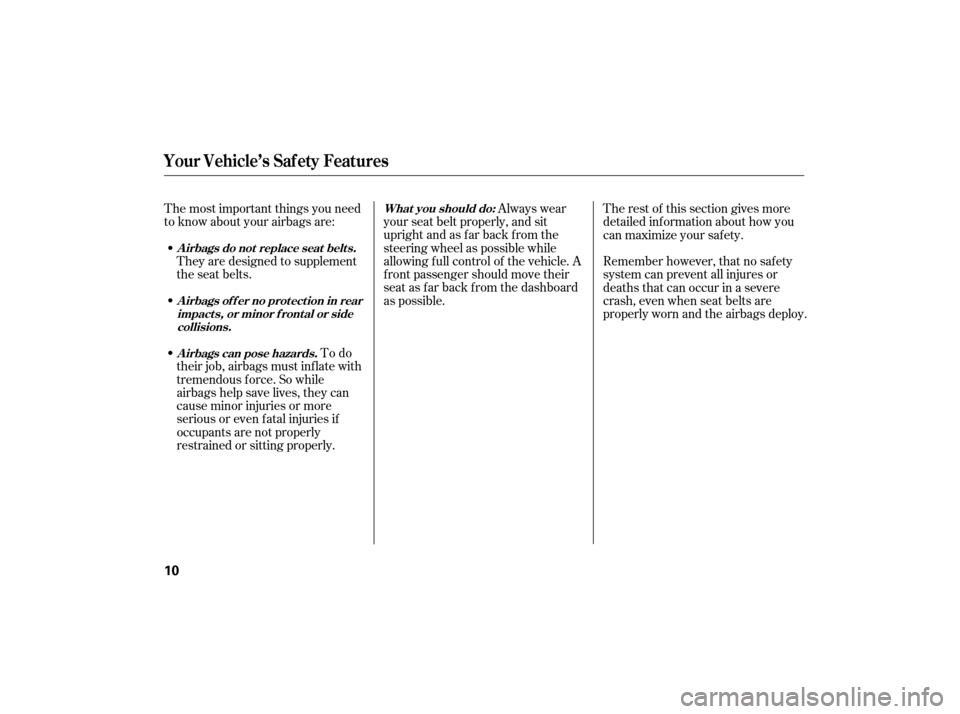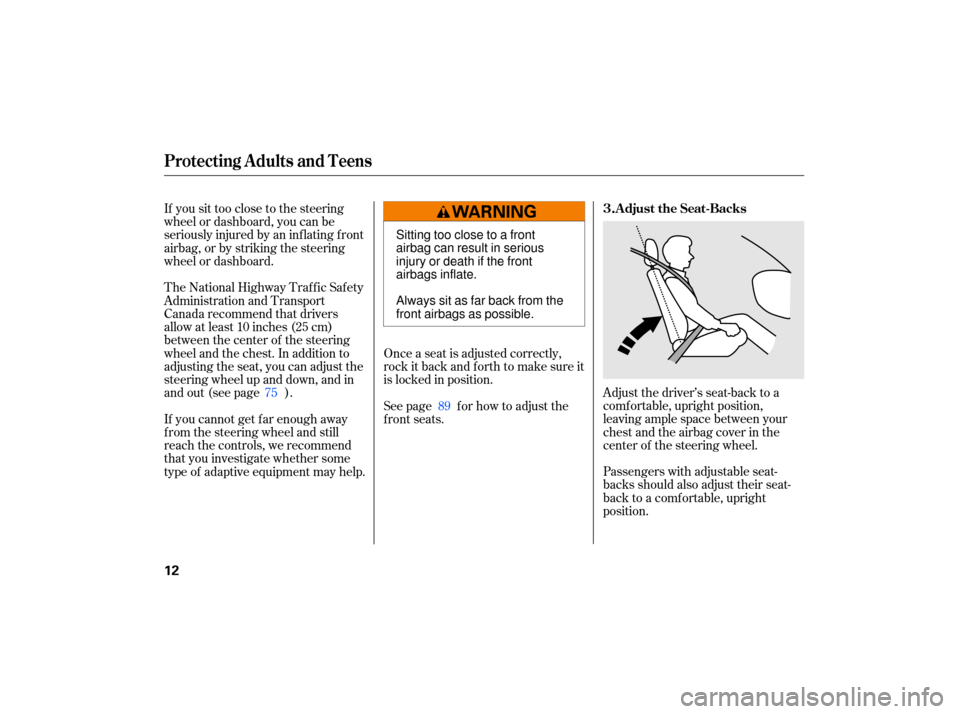Page 7 of 268
�Î
�Î
�Î
�Î
�Î
�Î
Only
on vehicles equipped with navigation system. Refer to the navigation system manual.
To
use the horn, press the pad around the ‘‘H’’ logo.
:
1:
2: Canadian
model only
Your Vehicle at a Glance
4
(P. 145)
WINDSHIELD
WIPERS/WASHERS
HORN CRUISE CONTROL BUTTONS
Vehicle with navigation system is shown
(P.
74) (P.
73)
INSTRUMENT
PANEL
BRIGHTNESS BUTTONS (P. 72)
DISPLAY CHANGE
BUTTON
(P. 65)
SEL/RESET
BUTTON
(P. 64)
REMOTE AUDIO
CONTROLS
(P. 143)
VOICE CONTROL
SWITCHES
HOOD RELEASE
HANDLE
(P. 152)
STEERING WHEEL
ADJUSTMENT
(P. 75) PASSENGER
AIRBAG OFF
INDICATOR
(P. 31)
(P. 74)
HAZARD
WARNING BUTTON
REAR WINDOW DEFOGGER
(P. 75)
HEATED MIRRORS
(P. 94)
HEADLIGHTS/TURN
SIGNAL
2 1
Page 13 of 268

The most important things you need
to know about your airbags are:They are designed to supplement
the seat belts.
To do
their job, airbags must inf late with
tremendous f orce. So while
airbags help save lives, they can
cause minor injuries or more
serious or even fatal injuries if
occupants are not properly
restrained or sitting properly. Always wear
your seat belt properly, and sit
upright and as f ar back f rom the
steering wheel as possible while
allowing f ull control of the vehicle. A
f ront passenger should move their
seat as far back from the dashboard
as possible. The rest of this section gives more
detailed inf ormation about how you
can maximize your saf ety.
Remember however, that no saf ety
system can prevent all injures or
deaths that can occur in a severe
crash, even when seat belts are
properly worn and the airbags deploy.
Your Vehicle’s Saf ety Features
Airbags do not replace seat belts.
A irbags of f er no prot ect ion in rearimpact s, or minor f ront al or sidecollisions.
A irbags can pose hazards. What you should do:
10
Page 15 of 268

Adjust the driver’s seat-back to a
comfortable, upright position,
leaving ample space between your
chest and the airbag cover in the
center of the steering wheel.
Passengers with adjustable seat-
backs should also adjust their seat-
back to a comfo rtable, upright
position.
If
you sit too close to the steering
wh eel or dashboard, you can be
seriously injured by an inflating front
airbag, or by striking the steering
wh eel or dashboard.
The National Highway Traffic Safety
Administration and Transport
Canada recommend that drivers
allow at least 10 inches (25 cm)
between the center of the steering
wheel and the chest. In addition to
adjusting the seat, you can adjust the
steering wheel up and down, and in
and out (see page ).
If you cannot get far enough away
from the steering wheel and still
reach the controls, we recommend
that you investigate whether some
type of adaptive equipment may help. See page f or how to adjust the
f ront seats. Once a seat is adjusted correctly,
rock it back and f orth to make sure it
is locked in position.
75 89
Protecting A dults and Teens
Adjust the Seat-Backs
3.
12
Sitting too close to a front
airbag can result in serious
injury or death if the front
airbags inflate.
Always sit as far back from the
front airbags as possible.
Page 25 of 268
Two SRS (supplemental restraint
system) front airbags. The driver’s
airbag is stored in the center of
the steering wheel; the front
passenger’sairbagisstoredinthe
dashboard. Both are marked ‘‘SRS
AIRBAG’’ (see page ).
Two side airbags, one for the
driver and one for a front
passenger. The airbags are stored
in the outer edges of the seat-
backs. Both are marked ‘‘SIDE
AIRBAG’’ (see page ).
Two side curtain airbags, one for
each side of the vehicle. The
airbags are stored in the ceiling,
above the side windows. The front
and rear pillars are marked ‘‘SIDE
CURTAIN AIRBAG’’ (see page ).
Your Airbag System includes:
2428
29
Additional Inf ormation About Your Airbags
22
(16)
(15)
(15)
(15) Side Impact Sensor (Second)
(16) Side Curtain Airbags
Page 58 of 268

This section gives inf ormation about
the controls and displays that
contribute to the daily operation of
your vehicle. All the essential
controls are within easy reach............................
Control Locations .56
............................
Instrument Panel .57
..........
Instrument Panel Indicators .58
.............................................
Gauges .64
.....................................
Odometer .64
..............
Display Change Button .65
.................
Current Fuel Mileage .65
...................
Temperature Gauge .65
...................................
Trip Meter .66
................
Average Fuel Mileage .66
..................................
Fuel Gauge .66
Outside Temperature
...................................
Indicator .67
..........
Check Fuel Cap Indicator .68
..................
Maintenance Minder .68
.........
IMA Battery Level Gauge .69
................
Charge/Assist Gauge .70
Controls Near the Steering ...........................................
Wheel .71
.
Windshield Wipers and Washers .72
...........
Turn Signal and Headlights .73
............
Daytime Running Lights .74
........
Instrument Panel Brightness .74
.................
Hazard Warning Button .74
.................
Rear Window Def ogger .75
..........
Steering Wheel Adjustment .75 ...............................
Keys and Locks .76
........................
Immobilizer System .78
................................
Ignition Switch .79
......................................
Door Locks .80
......................
Power Door Locks .80
..............
Childproof Door Locks .81
.
Auto Door Locking/Unlocking .81
.....................
Auto Door Locking .81
.................
Auto Door Unlocking .83
................................................
Trunk .86
........
Emergency Trunk Opener .86
.......................
Remote Transmitter .87
.................................................
Seats .89
..............................
Power Windows .92
.............................................
Mirrors .93
.................................
Parking Brake .94
...........
Interior Convenience Items .95
.........................
Beverage Holder .96
...........
Accessory Power Socket .96
....................................
Glove Box .96
...............
Console Compartment .96
.................................
Interior Lights .97
Instruments and Controls
Inst rument s and Cont rols
55
Page 66 of 268

If you turn the steering wheel to the
full left or right position repeatedly
while stopping or driving at very low
speed, you may feel slightly harder
steering due to overhe ating of the
steering gear box.
This
indicator normally comes on
when you turn the ignition to the ON
(II) position and goes off after the
engine starts. If it comes on at any
other time, there is a problem in the
electric power steering system. If
this happens, stop the vehicle in a
safe place and turn off the engine.
Reset the system by restarting the
engine. The indicator will not turn
off immediately. If it does not go off
after driving a short distance, or
comes on again while driving, take
the vehicle to your dealer to have it
checked. With the indicator on, the
EPS may be turn ed off, making the
vehicle harder to steer. This
indicator normally comes on for
a few seconds when you turn the
ignition switch to the ON (II)
position. When the brake system
indicator (amber) is on, there is the
problem with the Cooperative
Control with regenerative brake,
Creep Aid System or Brake Assist
(the normal brake operates properly).
Have your vehicle checked by your
dealer.
For more inf ormation, see page .
Continuously driving under those
conditions could damage the power
steering system.
173
Electric Power Steering
(EPS) Indicator
Brake System
Indicator
(A mber)
Instrument Panel Indicators
Inst rument s and Cont rols
63
U.S. Canada
Page 74 of 268
�Î
�Î
�Î
�Î
�Î
�ΠOnly on vehicles equipped with navigation system. Refer to the navigation system manual.
To
use the horn, press the pad around the ‘‘H’’ logo.
Canadian model only
:
1:
2:
Controls Near the Steering Wheel
Instru m ent sand Cont ro ls
71
SEL/RESET BUTTON
HORN
(P.
143)
DISPLAY
CHANGE BUTTON
(P. 65)
Vehicle with navigation system is shown.
REMOTE
AUDIO CONTROLS
(P.
74)
(P. 64) (P.
73)
INSTRUMENT
PANEL BRIGHTNESS
VOICE CONTROL
SWITCHES HEATED MIRRORS
REAR
WINDOW
DEFOGGER (P. 31)
PASSENGER
AIRBAG
OFF INDICATOR
HAZARD WARNING
BUTTON
(P. 74)
(P. 75)
HOOD RELEASE HANDLE
(P. 152) WINDSHIELD
WIPERS/WASHERS
(P. 72)
(P. 94)
STEERING WHEEL
ADJUSTMENT (P.
75) CRUISE
CONTROL BUTTONS
(P. 145)
HEADLIGHTS/TURN
SIGNAL
2
1
Page 78 of 268

The rear window defogger will clear
fog, frost, and thin ice from the
window. Push the defogger button to
turn it on and off. The indicator in
the button comes on to show the
defogger is on. If you do not turn it
off, the defogger will shut itself off
after about 15 minutes. It also shuts
off when you turn off the ignition
switch. You have to turn the
defogger on again when you restart
the vehicle. Make
sure the rear window is clear
and you have good visibility before
starting to drive. Make
any steering wheel adjustment
befo re you start driving.
Thedefoggerwiresontheinsideof
the rear window can be accidentally
damaged. When cleaning the glass,
always wipe side-to-side.
Pushing this button also turns the
mirror heaters on or of f . For more
inf ormation, see page . 94
CONT INUED
On Canadian models
Rear Window Def ogger Steering Wheel A djustment
Rear Window Def ogger, Steering Wheel A djustment
Inst rument s and Cont rols
75
Canadian
model
U.S. model
Adjusting the steering wheel
position while driving may
cause you to lose control of the
vehicle and be seriously injured
inacrash.
Adjust the steering wheel only
when the vehicle is stopped.